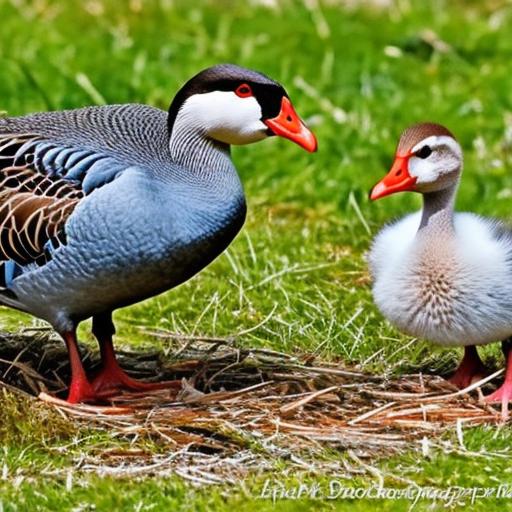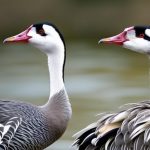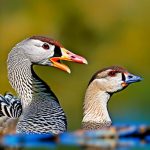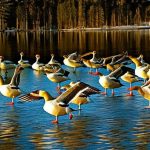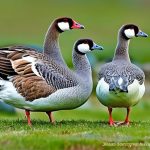Geese are known for their strong migratory instincts and their tendency to return to the same nesting sites year after year. They are also highly protective of their nesting areas and can become aggressive when they feel threatened. Understanding these behaviors is crucial when it comes to managing geese populations and preventing them from nesting in unwanted areas.
Geese typically begin nesting in early spring, with the female laying a clutch of eggs and incubating them for about a month. During this time, the geese become particularly territorial and will aggressively defend their nesting sites from perceived threats. This behavior can pose a problem for property owners, as geese may choose to nest in areas that are inconvenient or even hazardous, such as near buildings, walkways, or parking lots.
In addition to their protective nature, geese are also drawn to areas with ample food sources and open water. This means that properties with well-maintained lawns, ponds, or other water features may be particularly attractive to nesting geese. By understanding these behaviors, property owners can take proactive measures to discourage geese from nesting on their land and minimize potential conflicts.
Key Takeaways
- Geese are territorial and protective of their nesting sites, so understanding their behavior is crucial in deterring them.
- Creating a hostile environment for nesting by removing food sources and altering the landscape can discourage geese from settling in an area.
- Visual deterrents such as decoys, scarecrows, and reflective objects can help in deterring geese from nesting in a specific location.
- Auditory deterrents like sound machines and predator calls can also be effective in deterring geese from nesting.
- Removing potential nesting sites such as tall grass, shrubs, and other cover can make an area less attractive to geese looking for a place to nest.
- Physical barriers like fences, netting, and other structures can prevent geese from accessing and nesting in certain areas.
- Seeking professional assistance from wildlife management experts can provide effective and humane solutions for deterring geese from nesting in unwanted areas.
Creating a Hostile Environment for Nesting
One effective way to deter geese from nesting on your property is to make the area less hospitable to them. This can be achieved by implementing landscaping practices that discourage geese from feeling comfortable and safe in the area. For example, planting tall grasses or shrubs around potential nesting sites can make it difficult for geese to access these areas and may discourage them from nesting there.
Another strategy is to modify the terrain to make it less appealing to geese. This can include creating steep slopes or uneven surfaces around water features, which can make it difficult for geese to access the area and may deter them from nesting there. Additionally, installing barriers such as fences or netting around potential nesting sites can physically prevent geese from accessing these areas and may discourage them from attempting to nest on your property.
By creating a hostile environment for nesting, property owners can effectively deter geese from choosing their land as a nesting site. This approach is not only humane but also sustainable, as it does not rely on harmful chemicals or other methods that may have negative impacts on the environment.
Utilizing Visual Deterrents
Visual deterrents can be an effective way to discourage geese from nesting on your property. These deterrents work by exploiting the natural instincts of geese and creating an environment that is perceived as unsafe or threatening. One common visual deterrent is the use of predator decoys, such as fake coyotes or owls, which can create the illusion of danger and discourage geese from nesting in the area.
Another visual deterrent is the use of reflective objects, such as Mylar tape or balloons, which can create a disorienting and intimidating environment for geese. These reflective objects can be hung around potential nesting sites or near water features to create a visual barrier that may discourage geese from choosing the area as a nesting site.
In addition to predator decoys and reflective objects, visual deterrents can also include the use of scarecrows or other human-like figures that can create a sense of danger for geese. By utilizing these visual deterrents, property owners can effectively discourage geese from nesting on their land without causing harm to the birds or the environment.
Implementing Auditory Deterrents
Auditory deterrents can be an effective way to discourage geese from nesting on your property. These deterrents work by creating loud noises or sounds that are unpleasant or threatening to geese, which can make the area less appealing as a nesting site. One common auditory deterrent is the use of propane cannons or other noise-making devices that emit loud sounds at regular intervals, which can create a disruptive environment for geese and discourage them from nesting in the area.
Another auditory deterrent is the use of recorded distress calls of geese or other bird species, which can create a sense of danger and unease for nesting geese. These distress calls can be played through speakers or other sound-emitting devices to create a hostile environment that may discourage geese from choosing the area as a nesting site.
In addition to propane cannons and distress calls, auditory deterrents can also include the use of ultrasonic devices that emit high-frequency sounds that are unpleasant for geese. These devices can be placed around potential nesting sites or near water features to create a disruptive environment that may discourage geese from nesting on your property.
Removing Potential Nesting Sites
One proactive approach to managing geese populations is to remove potential nesting sites from your property. This can include clearing away tall grasses or shrubs where geese may choose to build their nests, as well as removing debris or other materials that could provide shelter for nesting geese. By eliminating potential nesting sites, property owners can effectively discourage geese from choosing their land as a nesting site and minimize potential conflicts.
In addition to removing potential nesting sites, property owners can also take steps to modify the landscape in ways that make it less appealing for geese to nest. This can include creating steep slopes or uneven surfaces around water features, which can make it difficult for geese to access the area and may discourage them from attempting to nest there. By taking proactive measures to remove potential nesting sites and modify the landscape, property owners can effectively deter geese from nesting on their land and minimize potential conflicts.
Using Physical Barriers

Physical barriers can be an effective way to prevent geese from accessing potential nesting sites on your property. This can include installing fences or netting around water features or other areas where geese may choose to nest, which can physically prevent the birds from accessing these areas and may discourage them from attempting to nest there.
Another physical barrier that can be effective in deterring geese is the use of floating barriers on water features. These barriers can create a physical barrier that prevents geese from accessing the water, making it less appealing as a nesting site. Additionally, floating barriers can also help to protect water quality and prevent damage to aquatic ecosystems caused by excessive goose activity.
By using physical barriers, property owners can effectively prevent geese from accessing potential nesting sites on their land without causing harm to the birds or the environment. This approach is not only humane but also sustainable, as it does not rely on harmful chemicals or other methods that may have negative impacts on the environment.
Seeking Professional Assistance
In some cases, managing geese populations and preventing them from nesting on your property may require professional assistance. There are wildlife management companies and other professionals who specialize in humane and sustainable methods for deterring geese and managing their populations. These professionals can provide expert guidance and assistance in implementing effective strategies for discouraging geese from nesting on your land.
Professional assistance may include conducting site assessments to identify potential nesting sites and developing customized management plans tailored to your specific property. These plans may include a combination of visual deterrents, auditory deterrents, physical barriers, and other strategies designed to effectively deter geese from choosing your land as a nesting site.
In addition to developing management plans, wildlife management professionals can also provide ongoing monitoring and maintenance services to ensure that the deterrent strategies are effective in preventing geese from nesting on your property. By seeking professional assistance, property owners can ensure that they are implementing humane and sustainable methods for managing geese populations and minimizing potential conflicts.
In conclusion, understanding the behavior of geese is crucial when it comes to managing their populations and preventing them from nesting on your property. By creating a hostile environment for nesting, utilizing visual and auditory deterrents, removing potential nesting sites, using physical barriers, and seeking professional assistance when needed, property owners can effectively deter geese from choosing their land as a nesting site while minimizing potential conflicts. These strategies are not only humane but also sustainable, as they do not rely on harmful chemicals or other methods that may have negative impacts on the environment. With proactive management and responsible stewardship of the land, property owners can successfully coexist with geese while protecting their property and the surrounding ecosystem.
Looking to keep geese from nesting in unwanted areas? Check out this helpful article on how to care for goslings for expert tips on managing geese and their nesting habits. Understanding the proper care and management of geese can help prevent them from nesting in undesirable locations, ensuring a more harmonious coexistence with these beautiful birds.
FAQs
What are some effective methods to keep geese from nesting?
Some effective methods to keep geese from nesting include using visual deterrents such as scarecrows or reflective tape, installing physical barriers like fences or netting, and using repellents or sprays to make nesting areas less attractive to geese.
Are there any natural ways to deter geese from nesting?
Yes, there are natural ways to deter geese from nesting. Planting tall grasses or shrubs around potential nesting areas can make it less appealing for geese to build their nests. Additionally, allowing natural predators like foxes or coyotes to inhabit the area can also discourage geese from nesting.
Is it legal to disturb or remove goose nests?
In many places, it is illegal to disturb or remove goose nests without proper permits or authorization. It is important to check local regulations and consult with wildlife authorities before taking any action to disturb or remove goose nests.
How can I prevent geese from nesting on my property without harming them?
To prevent geese from nesting on your property without harming them, you can use non-lethal methods such as installing physical barriers, using visual deterrents, and making the nesting area less attractive by removing food sources or water features. It is important to prioritize humane and ethical methods when dealing with wildlife.
What are the potential risks of geese nesting on my property?
Geese nesting on your property can pose risks such as property damage from their droppings, aggressive behavior during nesting season, and potential health hazards from their feces. It is important to address geese nesting in a way that minimizes these risks while also respecting the wildlife.
Meet Walter, the feathered-friend fanatic of Florida! Nestled in the sunshine state, Walter struts through life with his feathered companions, clucking his way to happiness. With a coop that’s fancier than a five-star hotel, he’s the Don Juan of the chicken world. When he’s not teaching his hens to do the cha-cha, you’ll find him in a heated debate with his prized rooster, Sir Clucks-a-Lot. Walter’s poultry passion is no yolk; he’s the sunny-side-up guy you never knew you needed in your flock of friends!

